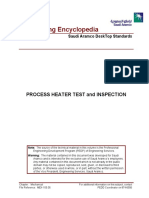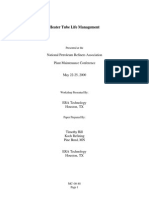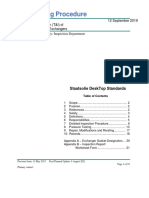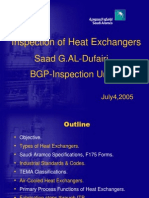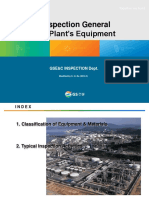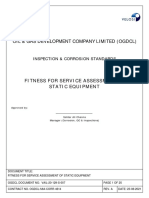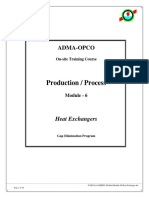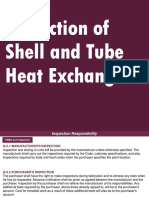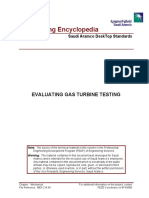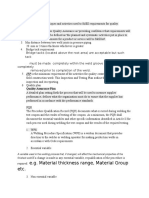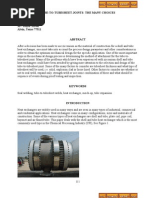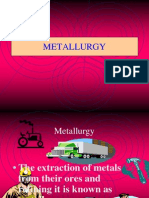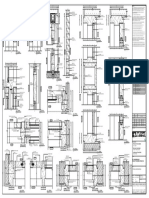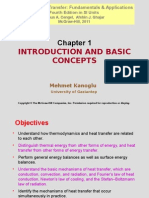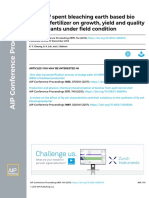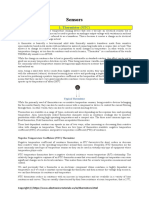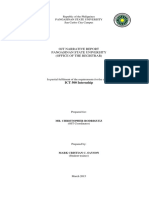CHEVRON Inspection and Testing Heat Exchanger
CHEVRON Inspection and Testing Heat Exchanger
Uploaded by
Vivek BhangaleCopyright:
Available Formats
CHEVRON Inspection and Testing Heat Exchanger
CHEVRON Inspection and Testing Heat Exchanger
Uploaded by
Vivek BhangaleOriginal Description:
Original Title
Copyright
Available Formats
Share this document
Did you find this document useful?
Is this content inappropriate?
Copyright:
Available Formats
CHEVRON Inspection and Testing Heat Exchanger
CHEVRON Inspection and Testing Heat Exchanger
Uploaded by
Vivek BhangaleCopyright:
Available Formats
900 Inspection and Testing
Abstract
This section covers both shop inspection of new equipment and inspection of existing units during maintenance turnarounds. The section on shop inspection covers information on shop testing and inspection to verify that new units are built to specification and with good workmanship. Heat exchanger failures cause many plant shutdowns and slowdowns. The cost of these failures is high due to lost production and replacement of the exchangers. Inspections responsibilities are to: (1) inspect existing exchangers when they are taken out of service to determine extent of repairs and remaining life; (2) verify that repairs are completed to the tolerances specified; and (3) maintain accurate long term records that facilitate accurate forecasting. This section covers inspection and testing requirements for new and existing shell and tube and air cooled heat exchangers. The type of damage found in exchangers is discussed, along with the primary inspection and testing techniques used to determine the condition of an exchanger. Detailed shutdown inspection checklists are included. Acceptable dimensional tolerances are discussed, and guidance on Safety Instruction Sheets (SIS) for shell and tube exchangers and air cooled heat exchangers is provided. Contents 910 911 912 913 914 915 920 921 922 923 Shop Inspection of New Exchangers General Comments Degree of Inspection Shop Inspection of Shell and Tube Exchangers Shop Inspection of Air Cooled Heat Exchangers Inspection Tasks Inspection of Existing Shell and Tube Exchangers and Air Cooled Exchangers 900-9 The Inspection, Engineering, Operation, and Maintenance Team Inspection Sequence Double Pipe Exchangers Page 900-3
Chevron Corporation
900-1
December 1989
900 Inspection and Testing
Heat Exchanger and Cooling Tower Manual
924 930 940 941 942 943 950 960 970
Inspection of State Registered Unfired Steam Generators Types of Damage Found In Exchangers Inspection and Testing Techniques Inspection Techniques Pressure Testing Techniques Safety Dimensional Tolerances Safety Instruction Sheets Maintenance Inspection Checklists 900-14 900-15 900-17 900-11 900-12
December 1989
900-2
Chevron Corporation
Heat Exchanger and Cooling Tower Manual
900 Inspection and Testing
910 Shop Inspection of New Exchangers
911 General Comments
Shop inspection is warranted for virtually all heat exchangers except off-the-shelf lube oil coolers. Inspection at the fabrication plant is normally done by the Quality Assurance (QA) section of Purchasing, or by an inspector contracted by Purchasing QA to inspect the exchanger. The purpose of shop inspection is to provide assurance that the equipment meets specification and order requirements, displays good workmanship, and is free of significant damage or defects. ASME Code uses the term Authorized Inspector to describe the inspector who works for a state, municipality, or insurance company and must be used by the fabricator to inspect the exchanger and sign the Manufacturers Data Report. The Authorized Inspector is not the same shop inspector that Chevron uses. The Authorized Inspectors responsibility is to verify that the exchanger is designed and fabricated in accordance with ASME Code, but he has no interest in and does not check such things as: 1. 2. 3. 4. 5. Dimensions or orientations (except for diameter and thickness). Presence of all required nozzles, baffles, or impingement plates; plumbness/squareness of nozzles. Limitations or restrictions in Company specifications on materials or welding processes. Special construction details in Company specifications that exceed ASME Code requirements. Inspection or testing requirements in Company specifications that exceed ASME Code minimums.
912 Degree of Inspection
Figures 900-1 and 900-2 show the degrees of inspection for shell and tube heat exchangers and for air cooled exchangers, respectively. The degrees of inspection ranging from one or two inspection visits to resident inspection. The visits themselves are listed in chronological sequence. Degrees of inspection are listed generally in accordance with the importance of the visit. Purchasing QA usually establishes the visits required based on the specifics of an order, but the job engineer can always participate in this decision. Figures 900-1 and 900-2 define the basic purpose for each visit but do not list all of the tasks that the Company inspector is required to complete during these visits (see Section 915).
Chevron Corporation
900-3
December 1989
900 Inspection and Testing
Heat Exchanger and Cooling Tower Manual
Fig. 900-1
Degrees of Inspection for Shell and Tube Heat Exchangers
Visit Notes: A. This visit is required for any parts of exchanger that are required to be PWHTD. This does not apply to stress relief of tube bends. B. This visit is made prior to any hydrostatic test and after PWHT if any. For exchangers with fixed tubesheets, internal inspection of the shell prior to attachment of closing tubesheet is required. C. This visit is required for all stacked exchangers with interconnecting nozzles. D. This visit is required for Degree 9, 10, and 11 inspection if finish paint is shop applied. General Notes: 1. Add supplementary visits A, C, and D as applicable. 2. Visits for purposes other than listed may be warranted and added (for example, to witness penetrant test of sealwelded tubes/tubesheets). 3. This matrix does not include all of the inspection tasks that an inspector completes during the required plant visits shown. A list of detailed inspection tasks can be several pages long. This list is normally part of the inspection plan for a particular exchanger. Inspection plans are usually prepared by Purchasing QA. 4. Each visit is not necessarily a full 8-hour day. 5. Problems with quality, specification compliance, or vendor cooperation/scheduling could increase the number of visits beyond the number shown.
December 1989
900-4
Chevron Corporation
Heat Exchanger and Cooling Tower Manual
900 Inspection and Testing
Fig. 900-2
Degrees of Inspection for Air Cooled Exchangers
Visit Notes: A. Outside face of tubesheet must be painted prior to tubing bundle if painting outside face is important; not normally done. B. Test erection and shop run are normally required. This visit can usually be included with visit for final inspection. General Notes: 1. Add supplementary visits A and B as applicable. 2. Visits for purposes other than listed may be warranted and added. 3. This matrix does not include all of the inspection tasks that an inspector completes during the required plant visits that are shown. A list of detailed inspection tasks can be several pages long. This list is normally part of the inspection plan for a particular exchanger. Inspection plans are usually prepared by Purchasing QA. 4. Each visit is not necessarily a full 8-hour day. 5. Problems with quality, specification compliance, or vendor cooperation/scheduling could increase the number of visits beyond the number shown.
Chevron Corporation
900-5
December 1989
900 Inspection and Testing
Heat Exchanger and Cooling Tower Manual
913 Shop Inspection of Shell and Tube Exchangers
Figure 900-1 identifies the different degrees of inspection for shell and tube exchangers. Figure 900-3 summarizes when to use the various degrees. Degree 4 is about the minimum for any shell and tube exchanger in hydrocarbon or critical service. Degree 10 is appropriate where any of the following apply. The exchanger has a fabrication time over 6 weeks. The exchanger is very large (over 4 feet diameter). The exchanger wall thickness is over 1-1/4 inch. The exchanger has a high pressure rating (flanges 600 pounds or more). The exchanger is fabricated from low alloy or high alloy steels. The exchanger has substantial cladding or weld overlay.
Degree 11 (resident inspection) is rarely applied to heat exchangers but could be considered during fabrication of heavy wall shells or channels (over about 4 inches thick). Visits for purposes in addition to those listed can be added to cover any special concerns.
914 Shop Inspection of Air Cooled Heat Exchangers
Figure 900-2 identifies the degree of inspection for air cooled heat exchangers. Degree 5 is about the minimum for any air cooled exchanger in hydrocarbon or critical service. Factors similar to those listed in Section 913 above are used to decide when more inspection visits are warranted; consult Purchasing QA for additional guidance.
915 Inspection Tasks
Figures 900-1 and 900-2 do not list all of the tasks the Company inspector is required to complete during the plant visits. These tasks are normally listed in an inspection plan prepared by Purchasing QA. The tasks listed in the inspection plan can be several pages long. Some of the principal tasks are: 1. 2. 3. 4. 5. 6. Verification that welding procedures and welders are qualified per ASME Code. Review of material test reports for principal exchanger parts and verification that exchanger parts are traceable to material test reports. Verification that welding procedures and preheat requirements are being followed. Visual inspection of all welds for flaws, contour, size, and reinforcement. Reading all radiographs (x-rays) and witnessing other nondestructive examination, if required. Complete dimensional and orientation check against Company reviewed vendor drawings.
December 1989
900-6
Chevron Corporation
Heat Exchanger and Cooling Tower Manual
900 Inspection and Testing
Fig. 900-3
Application of the Degrees of Inspection for Shell and Tube Exchangers (1 of 2) GUIDELINES FOR CHOOSING THE APPROPRIATE DEGREE OF INSPECTION FOR SHELL AND TUBE HEAT EXCHANGERS (NOTE THAT THESE ARE GUIDELINES ONLY)
Degree 1 when: 1. No Company specification applies, and 2. Exchanger: a. is small and simple (under 18 inch diameter), and b. is carbon steel (tubes can be another material), and c. has low pressure rating (under 250 psig), and d. is not in flammable or hazardous services. Degree 2 when: 1. No Company specification applies, and 2. Exchanger: a. is of moderate size (18 inch to 30 inch diameter), and b. is carbon steel (tubes can be another material), and c. has low pressure rating (under 250 psig). OR 3. Only one low dollar value hair-pin type exchanger is on a purchase order (an attempt is made to accomplish Degree 2 inspection in one visit to include inspecting parts, witnessing assembly, and witnessing hydrostatic tests). Degree 3 when: 1. Company specifications and/or standard drawings apply, and 2. Exchanger: a. is small and simple (under 18 inch diameter), and b. is carbon steel (tubes can be another material), and c. has low pressure rating (under 250 psig), and d. is in relatively noncritical service (choose at least Degree 4 for critical services).
Note Critical Service is difficult to define; judgment is required; factors to consider are type of service (contents of exchanger), consequences of failure with regard to the process, consequences of failure with regard to personnel and surrounding facilities.
Degree 4 (this is the normal minimum for exchangers in hydrocarbon service) when: 1. Company specifications and/or standard drawings apply, and 2. Exchanger: a. is of moderate size (18 inch to 30 inch diameter), and b. is carbon steel (tubes can be another material), and c. has moderate pressure rating (150 pound or 300 pound flanges), and d. is in relatively critical service.
Chevron Corporation
900-7
December 1989
900 Inspection and Testing
Heat Exchanger and Cooling Tower Manual
Fig. 900-3
Application of the Degrees of Inspection for Shell and Tube Exchangers (2 of 2)
Degree 5 when: 1. Company specifications and/or standard drawings apply, and 2. Exchanger: a. is of large size (over 30 inch diameter), and b. is carbon steel (tubes can be another material), and c. has moderate pressure rating (150 pound or 300 pound flanges), and d. is in relatively critical service Degree 6 when: 1. Company specifications and/or standard drawings apply, and 2. Exchanger: a. is of large size (over 30 inch diameter), and b. is carbon steel (tubes can be another material), and c. has shell thickness 3/4 inch or more, and d. has moderate pressure rating (150 pound or 300 pound flanges), and e. is in relatively critical service. Degree 7 (same as Degree 6 but when diameter, thickness of tubesheet, or tubesheet material warrants a visit for tubesheet/baffle inspection before installing tubes; this visit should always be made for tubesheets that are clad, weld overlayed, or will have tube/tubesheet welds, and can be considered for all moderate size and large size process exchangers.) Degree 8 (same as Degree 7 but when surface preparation required for painting is near-white or White Metal.) Degree 9 (same as Degree 7 but when surface preparation required for painting is near-white or White Metal and inspection of dry primer is judged to be warranted.) Degree 10 when: 1. Exchanger: a. fabrication time is over 6 weeks, or b. is very large (over 4 feet diameter), or c. has wall thickness over 1-1/4 inch, or d. has a high pressure rating (flanges 600 pound or more), or e. is fabricated from low alloy or high alloy steels. f. is fabricated from clad or weld overlayed material. Degree 11 (Resident inspection is rarely applied to heat exchangers but could be considered during fabrication of heavy wall shells or channels; heavy wall means over 4 inches thick.)
December 1989
900-8
Chevron Corporation
Heat Exchanger and Cooling Tower Manual
900 Inspection and Testing
7. 8.
Verification that all nozzles are present, and that they are correct size, rating, and material. Verification that bundle has all required baffles and support plates, and that baffle and tubesheet holes have been deburred; verification that tubes have been properly expanded into tubesheet holes. Review of Manufacturers Data Report to verify all entries are correct.
9.
920 Inspection of Existing Shell and Tube Exchangers and Air Cooled Exchangers
921 The Inspection, Engineering, Operation, and Maintenance Team
While much of the standard maintenance work on exchangers is initiated by inspection, the major decisions must be made with input from inspection, engineering, operations and maintenance. These decisions include: Retubing or rebundling Plugging tubes Nozzle replacement Major shell repairs or replacement Gasket surface repairs
The above organizations also must work together to establish the objectives of exchanger repairs well in advance of the shutdown. These objectives include: Exchanger or bundle design life Time between internal inspections (for some cases, this is determined by state regulations; i.e., waste heat boilers) Degree of internal or external leakage which is acceptable over the life of the bundle Degree of cleaning required (often dictated by process economics)
Section 1000 contains a Heat Exchanger Bundle Repair Worksheet for helping the engineer coordinate the decision making process.
922 Inspection Sequence
Inspection of existing exchangers and air coolers involves the following steps: 1. 2. Set objectives as discussed above. Examine inspection and maintenance records to note any trends and make initial recommendations.
Chevron Corporation
900-9
December 1989
900 Inspection and Testing
Heat Exchanger and Cooling Tower Manual
3. 4. 5.
Perform preshutdown inspection to note leaks and any areas which must be inspected in more detail when the unit is shut down. Determine need for bleeder tests prior to opening. Inspect and photograph shell and bundle after exchanger has been opened but before cleaning to look for patterns and types of fouling and evidence of plugged tubes. Inspect shell and bundle after cleaning and make recommendations for repairs. Inspect repairs and witness testing. Record gagings and repairs in the inspection file to anticipate what to expect in the future. Process paperwork for any code repairs or operating permits for state registered equipment.
6. 7. 8. 9.
Section 970 contains a detailed inspection checklist for exchangers and air coolers.
923 Double Pipe Exchangers
Double pipe or hairpin exchangers can be one pipe or several pipes inside another pipe. In either type of exchanger the corrosion is usually found in the area of the inlet nozzle and at the return bend. All these units are usually small enough in diameter to radiograph. Radiography can reveal the inner and outer pipe wall thickness, tube-wall thickness, and any fouling problem, without taking the unit out of service. Most repair work can therefore be planned before the plant is actually shut down. In one double pipe exchanger, called a chiller, the stock in the inner pipe is scraped using a scroll, and corrosion is usually found externally because of low temperature conditions. The scrolls may also break or become disconnected.
924 Inspection of State Registered Unfired Steam Generators
Like fired boilers, unfired steam generators require periodic inspection and state certification by qualified boiler inspectors. Generally, unfired steam generators are of tubular heat exchanger design. Consequently, inspection and repair follow the same general pattern as that used for process heat exchangers. 1. 2. 3. 4. The tube bundles are removed, cleaned, and inspected externally and internally. The shells and flash drums are internally inspected and ultrasonically gaged. The gage glasses, pressure gages and alarms are cleaned and serviced. The safety valves are removed, cleaned, tested and reset. Hydrostatic tests, when applied, should include the flash drum, if any, and all interconnected piping and appurtenances.
December 1989
900-10
Chevron Corporation
Heat Exchanger and Cooling Tower Manual
900 Inspection and Testing
The work copies of the inspection report and operating permit sheet are completed and processed as required by the local inspection organization.
930 Types of Damage Found In Exchangers
The various types of damage found in exchangers are discussed below. Refer to the Corrosion Prevention Manual for more information. End impingementwhere high velocity stock enters the tube and erodes the end. This can involve the tubesheet as well. Galvanic corrosionoccurs when the tube material and tubesheet material are apart on the galvanic scale, often with salt water as the electrolyte; e.g., for a Monel tubesheet with titanium tubes, the Monel tubesheet will corrode. Lodgement attackoccurs when an obstruction in the tube increases velocities at that point and erodes the tube. External corrosionwall thinning on the outside of the tube. Internal corrosionwall thinning on the inside of the tube. Dezincificationusually occurs on the I.D. of Admiralty brass tubes in saltwater service operating above 120F or when an inhibited grade of Admiralty was not used. Denickelificationusually occurs on the I.D. of copper-nickel tubes in saltwater service which have operated well above their normal tube-wall temperature. CO2 attackoccurs in condensing steam service and is common at the floating tubesheet end of the tube O.D. on vertical reboilers. Stress corrosion crackingusually occurs at a stressed point of tubes, such as at the U-bends. Can occur on any metal. Chlorides with stainless steels or NH3 with brass are examples where this can be a problem. Mechanical deformationcaused by improper sling placement when handling the bundle, for example. Vibration wearoccurs when the area between the tube and transverse baffle is too great or when the baffle spacing is too great, allowing the tube to vibrate in the hole. Seal weld crackingcracks in the tube-to-tubesheet seal weld. (Usually detected during a hydrotest.) Roll leakswhen the tube-to-tubesheet roll joint leaks. (Usually detected during a hydrotest.) Thermal shockusually occurs during an operation upset. Improper starting up or shutting down of equipment or loss of cooling water can cause shock. This commonly causes roll leaks.
Chevron Corporation
900-11
December 1989
900 Inspection and Testing
Heat Exchanger and Cooling Tower Manual
External impingementusually occurs on the tube O.D. in the area of the shell inlet nozzle. Can be remedied by installing an impingement device on the bundle, usually impingement rods or tubes. Necking downoccurs on the tube O.D. at the transverse baffle. It is caused by too large an area between the tube O.D. and the transverse baffle, allowing bypassing. Usually the baffle will erode as well as the tube, requiring replacement at the next retubing.
940 Inspection and Testing Techniques
This section discusses the primary inspection and testing techniques used to determine the condition of an exchanger before, during, and after repairs. It does not include visual inspection, which is very important.
941 Inspection Techniques
Ultrasonic (UT) gaging can be used to determine remaining wall thickness of the shell as well as defects in the wall. Micrometer measurements are used to determine tube wall thickness, depth of pitting, and metal loss on body flanges or tubesheets. Radiography can be used to check wall thickness and fouling in tubes. Radiography can be used on large bundles by sliding the film under the outer row of tubes. On large U-tube bundles the U-bends can be radiographed for wall thickness and fouling. On bundles with tubes 2-inch O.D. and larger, tube wall thickness and O.D. fouling can be identified using radiography by sliding a narrow film cassette in one tube and the source in another tube. Place the film in Tube A as shown in Figure 900-4. Put the source in Tube D. The two walls projected on the film will be the inside walls of Tubes B and C. Any fouling between Tubes B and C will show on the film. Several films can be shot with one exposure, depending on the tube layout and space available.
Fig. 900-4 Film Layout for X-Raying Bundles with Tube 2 inches and Larger
December 1989
900-12
Chevron Corporation
Heat Exchanger and Cooling Tower Manual
900 Inspection and Testing
Eddy current testing is an effective inspection tool for determining tube wall thickness. It is very useful for determining the tube wall in the center of tube bundles when specimen tubes are unattainable, such as in U-tube bundles. Ferrous as well as nonferrous tubes can be inspected; however, the tubes must be clean, and specimen tubes to confirm eddy current results are advisable before major repairs. Specimen tubes are tubes which have been removed from various locations throughout the bundle to determine the extent of corrosion in the bundle. Choosing the proper location of the specimen tubes is critical in developing an accurate profile of the corrosion. Often, eddy current is used to determine the worst areas of corrosion before pulling specimen tubes. Boroscopes connected to a TV can be used to visually inspect the tube interior. This technique will not measure wall thickness or pitting depth but can be a good visual tool for determining tube condition.
942 Pressure Testing Techniques
In general, exchangers out of service for repairs are pressure tested before the repairs to determine where work is required and after repairs to determine if the exchanger meets code requirements.
Test Pressures
The code hydrostatic test pressures are calculated using the code under which the exchanger was built (usually ASME). The exchanger fabricator generally supplies these pressures. The exchanger should be tested to full code test pressure after any repair work affecting the strength of the vessel.
Minimum Pressurizing Temperature (MPT)
The temperature of the pressurizing fluid must be above the MPT as discussed in Section 820 of this manual and in the Pressure Vessel Manual.
Tube Side Tests
Pressuring the tubes permits inspection of the channel cover gasket, channel, channel-to-tubesheet gasket, tubesheets, floating head gasket, floating head, and the tubes. Leaks can be identified by leakage at the joints; however, individual tube leaks are not identifiable because the tubesheets are inaccessible.
Shell Side Tests
Pressuring the shell side tests the shell, shell-to-tubesheet gasket, channel-totubesheet gasket, tubesheets, and tubes. If the channel has a removable cover this test allows individual leaking tubes to be plugged off because the tubesheet is accessible. Roll leaks also can be individually identified and repaired. U-tube bundles are easily tested with the shell enclosed. Floating head bundles require the use of a test ring to observe the floating tubesheet during the shell test. Figure 900-5 is a schematic of a test ring.
Chevron Corporation
900-13
December 1989
900 Inspection and Testing
Heat Exchanger and Cooling Tower Manual
Fig. 900-5
Test Ring - Floating Tubesheet (Courtesy of TEMA)
Leakage Tests
Tests for leakage can be conducted at the operating pressure for repairs not affecting the vessel strength, such as plugging tubes.
Bleeder Tests
Shell and tube bleeder tests can be applied quickly; however, they will indicate only that the unit is leaking. The type of leak will be unknown. When the shell or tubes are pressured, inspect for leaks at the channel or shell drains.
Testing Medium
The testing medium should be oil or water. Gas tests are more sensitive, but are extremely dangerous. Such tests over 15 psig require the approval of local management.
943 Safety
The inspector must remember that pressure tests involve certain hazards. In addition to gaskets blowing out, previously driven plugs can blow out as well. While witnessing pressure tests, the inspector should stand to one side. Unauthorized personnel should not be in the vicinity of the exchanger on test. The test pump must have a safety valve set at the test pressure, and a gage with a range of roughly double the test pressure (i.e., if test pressure is 150 psi, gage range should be 0 to 300 psi).
950 Dimensional Tolerances
Dimensional tolerances for standard shell and tube exchangers are tabulated in Section 2 of the Standards of Tubular Exchanger Manufactures Association (TEMA).
December 1989
900-14
Chevron Corporation
Heat Exchanger and Cooling Tower Manual
900 Inspection and Testing
Copies of TEMA Tables F-1 and F-2 are included for your quick reference. (See Figures 900-6 and 900-7.) Dimensional tolerances for air cooled exchangers are covered by API Standard 661, also included in this manual.
960 Safety Instruction Sheets
Safety Instruction Sheets (SISs) are used by several organizations as a singlesource summary document for important data on operating equipment. These data are important to operations, technical groups, inspection and maintenance, and they include: Safe operating limits (temperatures, pressures, rotational speeds, etc.) Particular precautions for safe operation Specified routine tests required for safe operation References necessary to operate and/or maintain the equipment Inspection/technical data (minimum thickness, corrosion allowances, test pressures, relief valve settings, minimum pressurizing temperatures, etc.)
SI sheets should be completed for (1) new exchangers and (2) existing exchangers that have been altered in any way that affects the SI sheet content. This includes: material changes, derating, minimum thickness changes. SI sheets are routinely filled out by a project engineer and countersigned by an operating representative. They become permanent records in the inspection groups and in the equipment manuals for the plants. Many technical groups also maintain compiled copies. Some organizations are now shifting this information to a centralized information database, PEIS (Plant Equipment Information System). Regardless of the format, the SI sheet is a good checklist of important information to have readily available. A significant problem with SI sheets has been getting them accurately and completely filled in prior to startup. One reason for this is that vendors are not always as responsive during the latter stages of a project, after the equipment has been purchased and installed. If you are committed to having SI sheets, you should consider methods to motivate vendors to complete them (or provide data) after all design and operating data are confirmed. Instructions for completing the following SI sheets are included in the Safety Instruction Sheet Section: EXH-EF-787 Shell and Tube and Double Pipe Heat Exchangers SI Sheet EXH-EF-788 Air Cooled Heat Exchangers SI Sheet
Chevron Corporation
900-15
December 1989
900 Inspection and Testing
Heat Exchanger and Cooling Tower Manual
Fig. 900-6
Standard Tolerances for External Dimensions, Nozzle and Support Locations of Heat Exchanger (Courtesy of TEMA)
December 1989
900-16
Chevron Corporation
Heat Exchanger and Cooling Tower Manual
900 Inspection and Testing
Fig. 900-7
Standard Clearances and Tolerances for Tubesheets, Partitions, Covers, and Flanges (Courtesy of TEMA)
970 Maintenance Inspection Checklists
Attached are inspection checklists for the following: Shell and Tube Exchangers (Figure 900-8) Air Cooled Exchangers (Figure 900-9)
This information was excerpted from the CUSA Manufacturing Inspection Manual.
Chevron Corporation
900-17
December 1989
900 Inspection and Testing
Heat Exchanger and Cooling Tower Manual
Fig. 900-8 Date:
Inspection ChecklistShell and Tube Exchangers (1 of 3) ____________________ ____________________ Tube side Shell side __________________ __________________ Initial: _______
Exchanger: Service:
Preshutdown Inspection: Discuss and agree on the shutdown objectives with Operations, Engineering, and Maintenance. Records Check: Review records and become familiar with corrosion history. Prepare a sketch indicating type and location of previous corrosion. External Visual Inspection: Inspect exchanger supports for proper bearing and anchoring. Look for corrosion on the shell where it is in contact with the concrete fireproofing. Check slide plates or slotted bolt holes for freedom of movement at the exchanger supports. Inspect support leg fireproofing for cracks and spalling and corrosion underneath. Inspect the anchor bolts for necking down at the baseplate. Where exchangers are saddled into a concrete support, inspect the shell for external corrosion. Inspect the insulation and retainers. Corrosion often occurs where moisture penetrates the insulation and the shell is not hot enough to dry it out. Insulated exchangers which operate below ambient temperature are susceptible to this type of corrosion. Representative sections, or even all of the insulation, should be removed to permit a complete external inspection and ultrasonic gaging. Inspect all small piping for leaks and external corrosion, including vents, drains, relief valves, plugs, and other small screwed fittings. Look for gasket leaks on the inlet and outlet piping flanges and at the channel or shell cover flanges. Evidence of leaks can be seen as deposits on the ground or platform under the unit. Check the packing gland on the bottom leg of the reboilers for leaks. Check gaskets and gasket surfaces for evidence of leakage. If the unit is a water cooler or condenser, note the water outlet temperature either by dial thermometer or by feel. Excessively high water temperature (above 120F for salt water) indicates possible fouling and probable high corrosion rates in the tubes. Ultrasonic Inspection: Take ultrasonic gage measurements at locations where internal corrosion is suspected. A sufficient number of measurements should be taken to provide reasonable assurance of the exchangers integrity. It is important to recognize that external gage points can reflect general corrosion rates, but that actual remaining wall thickness is probably lower. _______ _______ _______ _______ _______ _______ _______ _______ _______ _______
_______ _______ _______ _______ _______
December 1989
900-18
Chevron Corporation
Heat Exchanger and Cooling Tower Manual
900 Inspection and Testing
Fig. 900-8
Inspection ChecklistShell and Tube Exchangers (2 of 3)
Shutdown Inspection: Shell and Covers: Verify exchanger is properly cleaned for inspection. Cleaning can be done by water-washing, chemical cleaning, or by sandblasting. The amount of cleaning required depends on the severity of the corrosion and fouling in the unit. Internally inspect shells 20 inches or greater in diameter. Look for evidence of corrosion, noting particularly the nozzle, flange and shell welds, and the locations where the transverse baffles contact the shell. Take ultrasonic (UT) gage measurements in corroded areas and at representative locations on the shell cover and channel section to establish an accurate picture of the corrosion patterns. UT the shell at the inlet and outlet nozzles. Prior to cleaning, check gasket surfaces for evidence of leakage. After buffing, inspect gasket surfaces and flanges for evidence of corrosion or mechanical damage. Severely corroded gasket surfaces can require weld buildup and machining. Lightly damaged gasket surfaces can be repaired by machining or drawfiling. Inspect the baffles in channel sections for warpage, distortion, corrosion, or evidence of bypassing. Ensure that baffle stay rods are not cracked or broken. Inspect lifting lugs on channel sections and covers for mechanical damage or corrosion to ensure they are safe for continued use. Hammer-test or UT gage all small piping on the channel, shell, or shell cover and inspect all threaded fittings as necessary. On high pressure, or stainless steel piping, radiography should be used instead of hammer-testing. For services other than water, verify that all piping connections, including small piping, are welded up to the first root value. Eliminate connections less than 3/4 inch in size. Inspect longitudinal grooves or guides in the shell for the horizontal baffle in the bundle. Inspect alloy lining for cracked attachment welds and pinhole leaks. Have leaking or bulged lining removed for inspection under the lining. If channel cover staybolts are used, observe the bolt holes behind the lining. Graphitization frequently enlarges the holes and results in leaks. Repairs can be made by using oversize gaskets under the nuts. Inspect floating head bolts for evidence of corrosion, breakage or overstressing. Inspect split rings for warpage which can cause leaks at the floating head gasket. Bundles: A summary of the various types of bundle wear is included in Section 930 of the Heat Exchanger and Cooling Tower Manual. Before Cleaning: Record plugging and fouling conditions. Record clean washed areas indicative of high velocity and subsequent corrosion. _______ _______ _______ _______
_______
_______
_______ _______
_______ _______ _______ _______
_______ _______ _______ _______
_______ _______
Chevron Corporation
900-19
December 1989
900 Inspection and Testing
Heat Exchanger and Cooling Tower Manual
Fig. 900-8
Inspection ChecklistShell and Tube Exchangers (3 of 3) _______
Walk around the unclean bundle, take pictures, gather samples of fouling products and scale for analysis if necessary. Look for distortion, leaks, and any unusual condition. Much of this evidence is washed away when the bundle is cleaned. After Cleaning: Gage O.D. of accessible tubes with calipers. Use a mirror to visually inspect the full length of the outside of as many tubes as possible. Have the bundle rotated if necessary. Look for localized corrosion near the shell inlet nozzle in areas of impingement. Use a boroscope or a mirror and reflected light to visually inspect tube I.D. Look at tube ends for corrosion and thinning using a tube I.D. gage. Consider eddy current inspection for tube wall thickness. Pull specimen tubes in strategic areas if necessary. Split the tube and check the entire length for remaining wall thickness. The eddy current inspection may give you an idea of where to pull specimen tubes. Inspect the front and backsides of tubesheets for corrosion. Verify that all gasket surfaces are clean and free of defects and corrosion that could affect the tightness of the gasketed joint. Check the tubesheet baffle gasket surfaces for bypassing. Bypassing can corrode both the tubesheet gasket surface and the baffles. Check tubesheets with seal welded tubes for warpage which can cause excessive baffle bypassing. Inspect the tubesheet which is to be reused as a bundle to ensure that it is retubed. Look for the tube hole enlargement using a go/no-go gage. Look for pieces of thimbles left in the tubesheet serrations. Check for cracked ligaments. Note the history of the bundle. If roll leaks have been a problem, the ligaments are probably spongy, unable to hold a tight roll, and the tubesheet should be replaced. Inspect the segmental cross baffles for hole enlargement by moving the tubes and observing excess movement. Look for general thinning of all carcass components. Inspect the carcass for possible reuse when the bundle is retubed. Ensure that the frame will last the life of the bundle, especially when the tube material is being upgraded.
_______ _______ _______ _______ _______ _______ _______
_______ _______ _______ _______ _______
_______ _______ _______
December 1989
900-20
Chevron Corporation
Heat Exchanger and Cooling Tower Manual
900 Inspection and Testing
Fig. 900-9 Date:
Inspection ChecklistAir Cooled Exchangers _____________________
Equipment #: _____________________ Service: _____________________ Initial Tubes: Inspect fin condition and fouling. Have header plugs removed and measure tube I.D. with an I.D. gage. Consider eddy current inspection to determine tube wall thickness. Pull specimen tubes if the eddy current inspection indicates it is warranted. Header boxes and tubesheet: Inspect the header box and tubesheet for wall thickness. Check the plugs for impingement on the outlet sides. Check the plug and header hole threads for corrosion and galling. Fan, driver, and housing: Inspect the fan for cracking or distress. Check the guards to ensure they are intact, for personnel protection. Check the light gage steel housing for general condition. _______ _______ _______ _______ _______ _______ _______ _______ _______ _______ _______
Chevron Corporation
900-21
December 1989
You might also like
- Heat Exchanger Inspection Procedure PDFDocument33 pagesHeat Exchanger Inspection Procedure PDFshakeelahmadjsr80% (5)
- Inspection and Test Plan For Reciprocating CompressorDocument21 pagesInspection and Test Plan For Reciprocating CompressorNorman Morales100% (1)
- (RT) Exposure Time-ChartsDocument4 pages(RT) Exposure Time-ChartsVivek Bhangale75% (12)
- CHEVRON Maintenance Heat ExchangerDocument23 pagesCHEVRON Maintenance Heat Exchangerbabak mir50% (2)
- Heat Exchanger InspectionDocument43 pagesHeat Exchanger Inspectionabdul aziz100% (8)
- Thickness Monitoring Location Guide PDFDocument16 pagesThickness Monitoring Location Guide PDFdosetiadi100% (7)
- Base Line SurveyDocument10 pagesBase Line Surveycisar0007100% (1)
- New Heat ExchangerDocument12 pagesNew Heat ExchangerMosaddek100% (1)
- Saleas and Promotional Strategy of Amul Ice Cream NitilDocument93 pagesSaleas and Promotional Strategy of Amul Ice Cream NitilNitin R Gond50% (2)
- SOP 001 Dust MoppingDocument2 pagesSOP 001 Dust MoppingMade GileeNo ratings yet
- 00 SAIP 80 Process Equipment Insp GuideDocument90 pages00 SAIP 80 Process Equipment Insp GuideRaj BindasNo ratings yet
- ASME Guidance Articles On Repair Strategies - C. RoderyDocument35 pagesASME Guidance Articles On Repair Strategies - C. RoderyGuilherme Alencar100% (1)
- Fire Heater Test and InspectionDocument16 pagesFire Heater Test and InspectionMamdouh ElhanafyNo ratings yet
- Reapir and Altertaion Section 8Document52 pagesReapir and Altertaion Section 8waqas pirachaNo ratings yet
- Heater Tube Life ManagementDocument19 pagesHeater Tube Life ManagementWeniton Oliveira100% (1)
- Chevron RichmondDocument55 pagesChevron RichmondAZDOLMANNo ratings yet
- Heat Exchanger Inspection ProceduresDocument22 pagesHeat Exchanger Inspection Procedurespedro ylarretaNo ratings yet
- On Stream InspectionDocument17 pagesOn Stream Inspectionrajeshmohana100% (2)
- Refinery Pressure EquipmentDocument12 pagesRefinery Pressure EquipmentJorge Enciso Acuña100% (3)
- ASME 2 Related Post Construction Codes and StandardsDocument38 pagesASME 2 Related Post Construction Codes and StandardsInstech Premier Sdn BhdNo ratings yet
- STD 133Document37 pagesSTD 133ck19654840No ratings yet
- CHEVRON Shell and Tube Exchanger Component Design ConsiderationsDocument42 pagesCHEVRON Shell and Tube Exchanger Component Design Considerationsbabak mir83% (6)
- 5 16259779815014437Document26 pages5 16259779815014437Hafizul Hisyam Maysih Luzifah100% (1)
- UOP Inspection Training Manual Volume 1Document571 pagesUOP Inspection Training Manual Volume 1phuongnhsfc0% (1)
- Heat Exchanger InspectionDocument27 pagesHeat Exchanger Inspectionglazetm100% (23)
- 01 Saip 04Document17 pages01 Saip 04munnaNo ratings yet
- Inspection General For Plant's EquipmentDocument80 pagesInspection General For Plant's EquipmentRjeb mohamedNo ratings yet
- Inspection and Welding Repairs of Pressure VesselsDocument9 pagesInspection and Welding Repairs of Pressure VesselsClaudia Mms100% (1)
- TUV India HEAT EXCHANGER InspectionDocument43 pagesTUV India HEAT EXCHANGER InspectionParthiban NCNo ratings yet
- Damage Mechanism in Refinery AreaDocument83 pagesDamage Mechanism in Refinery AreaKevin Pradana100% (1)
- Highlighted ASME PCC 2Document122 pagesHighlighted ASME PCC 2Joerge Ryan Maramot0% (1)
- VAIL-20-129-S-007 - Fitness For Service Assessment of Static Equipment - Rev. ADocument25 pagesVAIL-20-129-S-007 - Fitness For Service Assessment of Static Equipment - Rev. Akunnar corrosion50% (2)
- Inspection of Unfired Pressure Vessel Std-128Document34 pagesInspection of Unfired Pressure Vessel Std-128dyke_engg100% (2)
- ASME CODE Requirements - PipingDocument6 pagesASME CODE Requirements - PipingJithin FrancizNo ratings yet
- Module-06-Heat Exchanger PDFDocument46 pagesModule-06-Heat Exchanger PDFHaitham Saleem Al-ani100% (1)
- Feild Inspection of Shell and Tube Heat ExchangersDocument4 pagesFeild Inspection of Shell and Tube Heat ExchangersMatthew BennettNo ratings yet
- In Servicepressurevesselinspectionaccordingtoapi 51010theditionoverview 180328042225 PDFDocument33 pagesIn Servicepressurevesselinspectionaccordingtoapi 51010theditionoverview 180328042225 PDFKrishna Vacha100% (2)
- Meridium RBI-580 Inspection Strategies - Q12016Document161 pagesMeridium RBI-580 Inspection Strategies - Q12016Saqib Ali100% (1)
- Retubing Plan On Heat Exchanger in Methanol PlantDocument22 pagesRetubing Plan On Heat Exchanger in Methanol PlantBayu FrilyanNo ratings yet
- Third Party Procedure For Heat Exchanger TestingDocument10 pagesThird Party Procedure For Heat Exchanger TestingVarun MalhotraNo ratings yet
- Heat Exchanger InspectionDocument7 pagesHeat Exchanger InspectionHamid Albashir100% (1)
- Pressure Equipment IMDocument43 pagesPressure Equipment IMInspection EngineerNo ratings yet
- Heat Exchanger Inspection PDFDocument8 pagesHeat Exchanger Inspection PDFreezmanNo ratings yet
- Thickness MonitoringDocument384 pagesThickness MonitoringIrvansyah Razadin100% (2)
- PRD Inspection NBIC PDFDocument42 pagesPRD Inspection NBIC PDFAsadAliNo ratings yet
- Best Practice SABP-A-026 17 July 2010 Cooling Systems Corrosion ControlDocument48 pagesBest Practice SABP-A-026 17 July 2010 Cooling Systems Corrosion Controlismaelarchilacastillo100% (1)
- Heat Exchanger InspectionDocument11 pagesHeat Exchanger InspectionVivek Bhangale100% (1)
- 0001 Lesson API-510Document26 pages0001 Lesson API-510erick CfNo ratings yet
- Underground Piping TestingDocument2 pagesUnderground Piping TestingDouglas HillNo ratings yet
- Heat Exchangers InspectionDocument31 pagesHeat Exchangers InspectionPrasetya Siregar100% (2)
- Chevron Maintenance & Inspection ProceduresDocument40 pagesChevron Maintenance & Inspection Procedureshazopman100% (3)
- API IntroduccionDocument23 pagesAPI Introduccionalbertogamboacotte100% (3)
- TUV India PRESSURE VESSEL InspectionDocument24 pagesTUV India PRESSURE VESSEL InspectionParthiban NCNo ratings yet
- Bolted Flanged Joint: Flanges, Studs & Gaskets. Recommended Practices for the Assembly of a Bolted Flange Joint.From EverandBolted Flanged Joint: Flanges, Studs & Gaskets. Recommended Practices for the Assembly of a Bolted Flange Joint.No ratings yet
- HTR900 Inspection, Maintenance, and TestingDocument27 pagesHTR900 Inspection, Maintenance, and TestingVicente Regulez FernandezNo ratings yet
- Saep 317Document22 pagesSaep 317brecht1980100% (1)
- Inspection and Test Plan For Pressure Vessel - Important PointsDocument21 pagesInspection and Test Plan For Pressure Vessel - Important PointsNorman MoralesNo ratings yet
- Summary of Pressure Vessel Inspection Highlights API 510Document20 pagesSummary of Pressure Vessel Inspection Highlights API 510kamrankm558No ratings yet
- Rica 231123 134035Document11 pagesRica 231123 134035Franz Vincent SarileNo ratings yet
- Changes Contained in Addendum 4 of API 570: Piping Inspection CodeDocument7 pagesChanges Contained in Addendum 4 of API 570: Piping Inspection CodeabuyiboNo ratings yet
- DRI800 Inspection and TestingDocument21 pagesDRI800 Inspection and Testingmika cabelloNo ratings yet
- Evaluating Gas Turbine TestingDocument27 pagesEvaluating Gas Turbine TestingReshmi Vinu100% (2)
- Interview QuestionsDocument3 pagesInterview Questionspraveentien100% (1)
- Ultrasonic Testing of Materials at Level 2Document278 pagesUltrasonic Testing of Materials at Level 2albertzaldivia87% (15)
- Fabrication NotesDocument76 pagesFabrication NotesnicekhanNo ratings yet
- Heat ExchangersDocument49 pagesHeat Exchangersbluelion_19100% (1)
- Tube To Tube SheetDocument9 pagesTube To Tube Sheetcmpatel_00100% (2)
- Heat Exchanger InspectionDocument11 pagesHeat Exchanger InspectionVivek Bhangale100% (1)
- MetallurgyDocument13 pagesMetallurgyVivek BhangaleNo ratings yet
- 4.2.2 ZXMW PR10 Digital Microwave System Commissioning Manua PDFDocument69 pages4.2.2 ZXMW PR10 Digital Microwave System Commissioning Manua PDFMebre LemaNo ratings yet
- A8.3 TYPICAL DOOR DETAILS - LayDocument1 pageA8.3 TYPICAL DOOR DETAILS - LayVanshika Dogra100% (1)
- Download Full Salesforce B2C Solution Architect's Handbook - Second Edition Mike King PDF All ChaptersDocument50 pagesDownload Full Salesforce B2C Solution Architect's Handbook - Second Edition Mike King PDF All Chaptersasionswanty100% (4)
- Chapter 4 - Investment Appraisal-Further Aspects of Dicosunted Cash FlowsDocument39 pagesChapter 4 - Investment Appraisal-Further Aspects of Dicosunted Cash FlowsInga ȚîgaiNo ratings yet
- Rural Marketing in India: Executive SummaryDocument51 pagesRural Marketing in India: Executive SummaryHriday PrasadNo ratings yet
- M.Tech. Power Systems & Automation PDFDocument17 pagesM.Tech. Power Systems & Automation PDFPavan KumarNo ratings yet
- Day 2 - IGBC ProcessDocument6 pagesDay 2 - IGBC ProcessManish BokdiaNo ratings yet
- Introduction and Basic Concepts: Heat and Mass Transfer: Fundamentals & ApplicationsDocument46 pagesIntroduction and Basic Concepts: Heat and Mass Transfer: Fundamentals & ApplicationsMatthew ShieldsNo ratings yet
- STP8 10 3AV 40 BE en 10Document98 pagesSTP8 10 3AV 40 BE en 10Tiên Lê Trần MỹNo ratings yet
- Alpha Software Manual Versb English PDFDocument44 pagesAlpha Software Manual Versb English PDFTamás LakatosNo ratings yet
- Rick's Cabaret BMC 092711 FDocument15 pagesRick's Cabaret BMC 092711 FAndre TerrellNo ratings yet
- Tiu 2 AunDocument5 pagesTiu 2 Aunjose teixeira100% (1)
- Lowes Q3 Earnings Call InfographicDocument1 pageLowes Q3 Earnings Call Infographictoloc03No ratings yet
- Project Electric BikeDocument28 pagesProject Electric Bikeachint9100% (1)
- DBA Cheat SheetDocument13 pagesDBA Cheat Sheetcallit007No ratings yet
- Wall Street Courier Services Inc. Payslip: Earnings AdjustmentDocument1 pageWall Street Courier Services Inc. Payslip: Earnings AdjustmentFerdinand Salvador SrNo ratings yet
- Effect of Spent Bleaching Earth Based BioDocument6 pagesEffect of Spent Bleaching Earth Based BioLuki Wahyuning TiyasNo ratings yet
- Forsk AtollDocument16 pagesForsk AtollcansuarezNo ratings yet
- Pentium Celeron N Series Datasheet Vol 1 PDFDocument248 pagesPentium Celeron N Series Datasheet Vol 1 PDFTri Sutrisno100% (2)
- New Generation University Introductory Microeconomics Midterm AssignmentDocument2 pagesNew Generation University Introductory Microeconomics Midterm AssignmentAhmedNo ratings yet
- Sreedevi CV 1 PDFDocument2 pagesSreedevi CV 1 PDFsubuNo ratings yet
- مدى تأثير المناخ التنظيمي في منطقة سلفيت التعليميةDocument34 pagesمدى تأثير المناخ التنظيمي في منطقة سلفيت التعليميةAhmed Kadem ArabNo ratings yet
- IR SensorsDocument17 pagesIR SensorsShahana sayyedNo ratings yet
- Ojt Narrative Report Pangasinan State University (Office of The Registrar)Document9 pagesOjt Narrative Report Pangasinan State University (Office of The Registrar)Mia Georgie SoteloNo ratings yet
- Quiz in Developing An ICT Project For Social ChangeDocument2 pagesQuiz in Developing An ICT Project For Social ChangePrincess Ira SantillanNo ratings yet
- Company TypesDocument6 pagesCompany TypesTeodora IoanaNo ratings yet
- Renaissance KMCDocument35 pagesRenaissance KMCSahil AntilNo ratings yet
- RTS SyllabusDocument3 pagesRTS SyllabusthejasNo ratings yet












